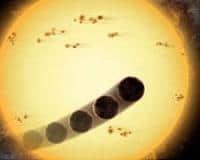Since 1995, over 500 planets that don’t orbit our Sun have been discovered, with the numbers increasing more and more in the past years. But only recently did astrophysicists observe that in some of these cases, the star seems to be spinning in one direction, and the planet orbits it in the totally opposite direction – totally counterintuitive and against what we generally believe about planetary formation.
“That’s really weird, and it’s even weirder because the planet is so close to the star,” said Frederic A. Rasio, a theoretical astrophysicist at Northwestern University. “How can one be spinning one way and the other orbiting exactly the other way? It’s crazy. It so obviously violates our most basic picture of planet and star formation.”

“Once you get more than one planet, the planets perturb each other gravitationally,” Rasio said. “This becomes interesting because that means whatever orbit they were formed on isn’t necessarily the orbit they will stay on forever. These mutual perturbations can change the orbits, as we see in these extrasolar systems.”
The thing is, typically enough, astrophysicists have considered our solar system to be typical for the Universe, but observations don’t seem to confirm this belief.
“We had thought our solar system was typical in the universe, but from day one everything has looked weird in the extrasolar planetary systems,” Rasio said. “That makes us the odd ball really. Learning about these other systems provides a context for how special our system is. We certainly seem to live in a special place.”
The physics they used to solve this issue is basically orbital mechanics, but the approach they needed, and the amount of detail and successful approximation is absolutely stunning.
“It was a beautiful problem,” said Naoz, “because the answer was there for us for so long. It’s the same physics, but no one noticed it could explain hot Jupiters and flipped orbits.”
“Doing the calculations was not obvious or easy,” Rasio said, “Some of the approximations used by others in the past were really not quite right. We were doing it right for the first time in 50 years, thanks in large part to the persistence of Smadar.”
Of course, a computer model was necessary, but the steps that have to be taken until that computer model are the most important. It takes a sharp mind, and a correct approach to take everything from paper and put it on a hard disk.
“It takes a smart, young person who first can do the calculations on paper and develop a full mathematical model and then turn it into a computer program that solves the equations,” Rasio added. “This is the only way we can produce real numbers to compare to the actual measurements taken by astronomers.”
In their model, they created a simple solar system with a star similar to the Sun and two planets; one of them is a Jupiter-like planet that forms far from the star, where this kind of planets are thought to form. The other planet is even farther away from the sun than the inner planet, and it interacts gravitationally with it, shaking the whole system.
The effects of this model are the exact ones they were trying to get: the inner gas giant moves closer and closer towards the Sun and starts orbiting in the opposite direction of the star’s spin. These changes occur because (according to the model) the two orbits are exchanging angular momentum, and the inner one loses energy via strong tides. The gravitational couple forces the inner planet to adopt an eccentric, needle-like orbit; in order for this to happen, it has to lose a lot lot of angular momentum, giving it away to the outer planet, and thus its orbit gradually shrinks because of all the dissipated energy, pulling it closer and closer to the star, and sometimes flipping its orbit in the process.










